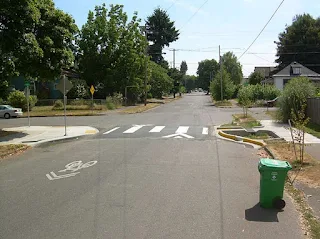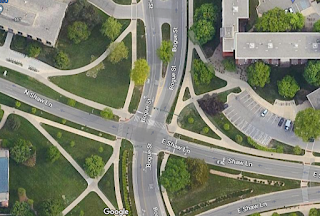"Traffic Calming" is the deliberate inclusion of physical challenges to the roadway to reduce the average speed of motorists from Point A to Point B.
 |
| Chokers or curb extensions, or in 2024 (as BBB spending kicks in) Biden or Pete Butt-lifts. |
You have all encountered them. Speed-bumps are the most obvious ones but Traffic Calming methods also include the seemingly random discontinuation of lanes, the addition of center-turn lanes where not otherwise justified, on-street parking, diagonal parking in "town centers", extending sidewalks into the traffic lane to narrow it (called a choker in the trade), medians to narrow lanes and reduce forward visibility, prohibiting through-traffic by forcing right-turns.
 |
| Snowplows are rough on raised cross-walks. There are also drainage and black-ice risks with them. |
Traffic Calming Handbook Part I, Traffic Calming Handbook Part II and Part III
The stated objective of Traffic Calming is to make the streets safer for pedestrians and bicyclists.
It doesn't work!
According to this paper from Canada, adding parking to a major road increases the risk of bicycle accidents by 59% and adding "traffic calming" to residential streets increases the risk to bicycles by 29%.
Aside: Take these numbers with a grain-of-salt because the numbers in the study are not huge. It is entirely defensible to round the differences down to the nearest 10%.
Interestingly, the effect of adding bicycle lanes to residential streets is a wash.
Also interesting, a plain-Jane, nothing special residential street with the normal, uncomplicated intersections and stop signs (where appropriate) is significantly safer than paved, multi-use paths and dedicated bike-paths with the multi-use posing 55% more hazard and the dedicated bike-path posing 16% more hazard than old-fashioned, residential streets.
Baffled?
Multi-use paths put pedestrians (often walking abreast) on the same surface as bikes. Pedestrians cranking out 3 mph, top-end. Bikes handily capable of five times that speed. A bike traveling at 15mph plowing into two pedestrians is a very, very big deal.
Another factor is that multi-use paths wind through the landscape. That is part of their charm. It also means that forward visibility is impaired.
 |
| An intersection at a local university. Narrower paths are mixed pedestrian, skate-boards, e-scooters and bikers. |
Roads for motor vehicles are typically much straighter and are (were) specifically designed for enhanced visibility so drivers could better adjust to hazards. Roads were also designed so major hazards are either directly ahead of the driver or perpendicular to the driver's direction of travel. That simplified cognitive processing.
The counter-intuitive findings for bike-safety and "Traffic Calming" is undoubtedly due to the unexpected, increased cognitive demands on the drivers. There you are cruising down Waverly Road, listening to the Zak Brown band when BAM! you lose a lane.
The increased risk of accidents where there is parking is TOTALLY intuitive. Doors are thrown open and the bike plows into it. The driver backs out of the diagonal parking into the path of a bicyclist.
The entire concept of "Traffic-Calming" is totally back-asswards. The designers add risk and count on the driver's tendency to normalize it to cause the vehicle to slow down. Speed became the metric at the expense of safety. It is the equivalent of giving people cancer so they will lose weight.
Miscellaneous notes
The most hazardous item to a bicycle is a rail crossing. It increases the baseline risk by a factor of 3.
The second most hazardous condition for a bike is a downgrade. It more than doubles the baseline risk.
The third most hazardous, single item is construction. It almost doubles the baseline risk.

Villages in Germany and Holland add Drempels ( BIG speed bumps) and Big Ole honkin' concrete planters to choke off entrance and exit to the villages. Spaces are left for bikes to avoid both, but cars dont fit through the bike bypasses.
ReplyDeleteIrritating, but it keeps the speed down.
Something like this https://highways.dot.gov/sites/fhwa.dot.gov/files/images/Safety/tceprimer107.jpg?
DeleteI perceive visibility issues with bikes and pedestrians popping into traffic before drivers can respond. Making it big enough for the drivers to see means it is big enough to hide bikes, kids, strollers, dogs and old-geezers.
I know writing tickets is unpopular but it seems like they are trying very, very hard to not use that tool.
There is currently an elderly woman in England in jail for manslaughter because another old lady riding a bicycle on a narrow footpath, almost ran her down. She waved her arms and shouted in alarm and the old cyclist rode past her then fell off, in the path of a vehicle which killed her. (She chose to ride on a footpath, not a cycle path, and not on the road and a pedestrian was 'expected' to get out of her way, or face charges. You couldn't make it up - although, typically, there appears to be some 'issue' with how 'friendly' her family are with the police and judge, being golf-partners and all).
ReplyDeletein the watermelon lexicon cyclists are 'superior' to all other road users, as such 'their' interests are prioritised over everyone else's and safety (and common sense apparently). Although as in all supposed preferences, it's really a way to punish 'the opposition, in this case drivers (they could care less about cyclists, but their a useful tool).
The only places where cycle-paths work are either where they are an entirely separate network, or cycles are the majority of traffic. Whichever examples used to push this idiocy are 'all' one or the other.
At its root it is, SSDD, woke collectivist thinking. they feel some are driving too fast, don't punish the speeders, but punish everyone else instead. Cyclists show increased 'dangerous/risky behaviour' and rather than punish 'them', everyone else is blamed. They have their favourites (cyclists good, drivers bad) so are attempting to force it on everyone.
To add to the calculation: A significant fraction of both the road and pedestrian accident figures are in fact 'cycle related' (but concealed); and 'every' supposed 'safety' measure (including seat-belts and motorcycle helmet legislation) has been shown to definitively and significantly 'increase' the risk, risky behaviour, and the casualties involved, i.e. they all have the (intentionally?) opposite effect than claimed.
It's interesting to review studies regarding incidents where 'traffic safety' items (like traffic lights) fail. There is an initial increase of minor accidents (as people struggle with the change), then a drastic drop in accidents (over when the items were working) as 'people cope' and adjust their behaviour. So? As in all things, anything government or experts gets involved in 'always' has the result of making the problem ... worse (and makes 'some people' rich).
Want to know why there's an increase in cycle paths and road-calming measures? Look to see who in government (national or local) is getting rich by (purely coincidentally) having a company that offer these things (Is my cynicism showing?).
Yes, as a matter of fact your cynicism is showing.
DeleteI think you are right in this case. I think the road designers are deliberately choosing more accidents in exchange for lower-energy collisions that result in fewer fatalities, in total, for the people in the vehicles.
If you are familiar with mechanical-engineer-speak, they errorred when they defined their control-volume and did not include non-motorists in their calcs; including the trash-man, the peds and the yellow shirts doing construction and landscaping beside the road.
And when people die, it will be the driver's fault... Grrr...
ReplyDeleteI recollect back in the 1980's seeing a bicyclist who had been traveling the paved pathway along the Charles River in Cambridge, near Harvard University. It was a weekend, and the pathway was full of pedestrians and other cyclists. This one cyclist had apparently been going rather fast, weaving around the slower pedestrians, and he nailed a park bench next to the pathway while trying to do one of his swerves. He was lying next to his wrecked bike with obvious compound fractures in his arm and leg, surrounded by good samaritans trying to do something. Those benches were built solid and fastened to concrete.
ReplyDeleteI'm curious what effect roundabouts have, in light of the information above. The area that I live in is adding roundabouts everywhere. It seems very dangerous for those on foot.
ReplyDelete